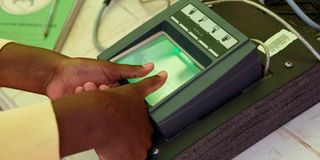IEBC touts electronic voter identification in new plan

A resident registers as a voter in Roysambu, Nairobi, in February.
The electoral agency has dropped the use of physical voter registers in polling stations for electronic identification in the August 9 elections.
The new rule by the Independent Electoral and Boundaries Commission (IEBC) means that voters who cannot be identified electronically will be turned away from polling stations.
In a response to demands by the Azimio la Umoja One Kenya Coalition Party, whose presidential candidate is former prime minister Raila Odinga, IEBC says the decision to phase out the complementary voter identification mechanism was borne out of cases of misuse of the physical register in the past.
“IEBC made a decision not to use the printed register of voters based on the findings of the Post-Election Report for the 2017 General Election and fresh presidential elections. It was established that the use of the printed register of voters provided an avenue for misuse during the voting process,” IEBC chairman Wafula Chebukati said.
In the 2017 elections, IEBC employed a complimentary mechanism that allowed voters not identified electronically to be allowed to vote on the strength of the printed register, with candidates’ agents signing off on the fact. IEBC had in the October 26, 2017 repeat presidential elections released logs that showed that 99 per cent of the voters were identified electronically.
Also Read: Ruto, Raila fight Uhuru polls Bill
But drilled down to the specifics, IEBC’s plan of completely abandoning the physical register might still be riddled with problems. In the repeat presidential election that Mr Odinga boycotted, OT-Morpho’s data showed that 5,525,487 voters were identified using biometric finger identifications, 1,622,276 through the alpha-numeric search, and 428,043 using the documents search in the register. An alpha-numeric search identification is one where voters’ passports or identity cards are scanned, and when a positive match pops up, they are asked to place their fingers on the kit for their biometrics to be recorded.
A document search is one where the numbers in the documents used to register are keyed in and voters asked to confirm their biometrics. The removal of the physical register cures a 2017 anomaly where voters identified did not match those that voted.
The presence of the complementary system — where voters were allowed to vote if they were in the physical voters’ register and could not be identified biometrically — meant that the Kenya Integrated Election Management System (Kiems) kits only recorded those that were identified using the system.
“Please also note that the voters identified manually (without using the Kiems kits) or the voters non validated by the operators during the identification process are not counted as identified voters,” Mr Olivier Charlanes, OT Morpho’s vice-president in charge of Africa said in the letter to the IEBC then.
Following the rejection of the regulations that would have allowed IEBC officials in polling stations with no network to get out of their stations in search for it, Mr Chebukati says they will employ the use of satellite technology.
The letter to Azimio also gives a breakdown of the 1,068,444 voter transfers done, following complaints by, among others, Deputy President William Ruto, who said the numbers were mostly from what he considers his strongholds. In the list, Nairobi leads with the most voter transfer requests at 125,867, followed by Nakuru 57,466, Kiambu 50,438, and Mandera 50,328.
For Mandera, the transfer requests were more than the total number of voters registered between 2017 and 2022 (40,210).
Others are Kakamega (42,126), Garissa (41, 513), Mombasa (33,183), Kisii (33,044), Wajir )(32,190), Machakos (31,900), Siaya (28,888), Bungoma (28,529), Kisumu (28,204), Homa Bay (27,696), Migori (23,841), Trans Nzoia (23,609), Kajiado (22,829), and Nyamira (20,923).
IEBC had also been questioned on how it will load 104,962 Sim cards to the 52,481 Kiems tablets, considering that the team took 10 days to configure just 5,000 of them for the register verification.
“IEBC has put up a production facility and hired staff for purposes of installing application software, the digital register and insertion of Sim cards. The installation of the software is done wirelessly without human intervention. SD cards populated with the register of voters shall be inserted into the Kiems kits. They will then be packaged and delivered to the constituencies for the elections,” Mr Chebukati said.
Yesterday, civil society groups, including Transparency International, Elections Observations Group(Elog), Center for Multiparty Democracy, Mzalendo Trust, and Electoral Law and Governance Institute for Africa demanded a list of polling stations with no network.
“The commission announced that close to 1,111 polling stations are out of 3G and 4G coverage and [they will use] satellite modems to transmit presidential results from these stations. In the spirit of accountability, we call upon the Communications Authority of Kenya to confirm these numbers and explain why this is the case. Similarly, we urge that [IEBC] makes public the names of these polling stations and explain how it will identify which tablet a form 34A will be coming from given that these polling stations lack of coverage,” they said in a joint statement. They demanded full access to the list of irregular transfers made.
[email protected] Additional reporting by Mercy Simiyu





